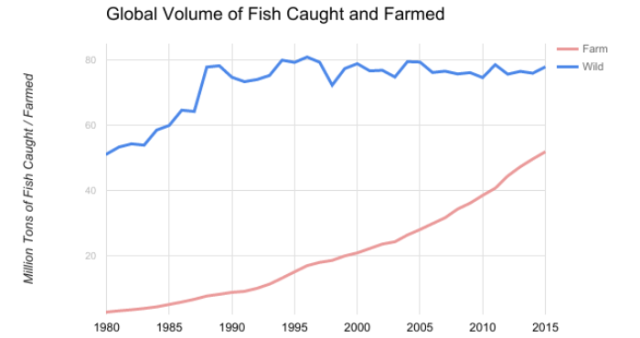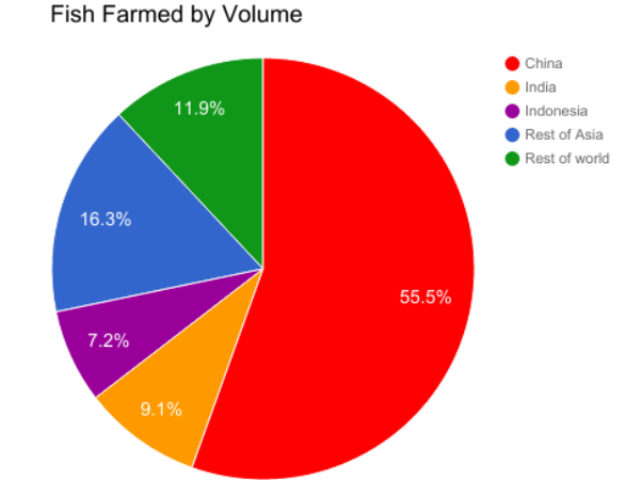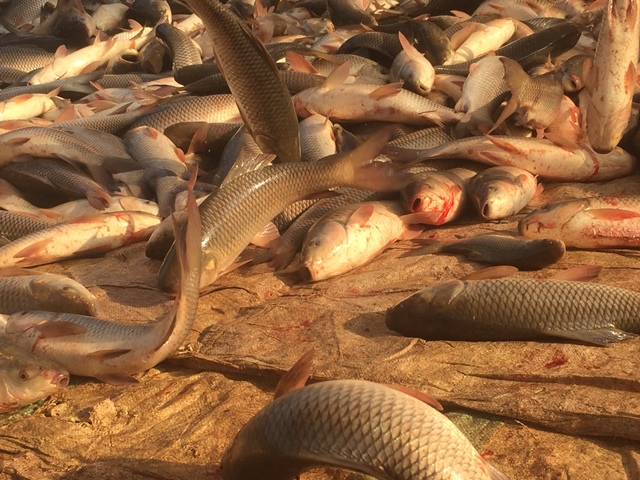This post originally appeared in the monthly farm animal welfare newsletter written by Lewis Bollard, our program officer for farm animal welfare. Sign up here to receive an email each month with Lewis’ research and insights into farm animal advocacy. Note that the newsletter is not thoroughly vetted by other staff and does not necessarily represent consensus views of Open Philanthropy as a whole.
When we think of farm animals, we likely don’t think of carp. But this family of freshwater fish — which includes the three most populous farmed fish species in the world: crucian carp, silver carp, and catla — is likely the most numerous farmed vertebrate animal in the world, with an estimated 25-95 billion farmed every year. (About 62 billion chickens are farmed every year, but each is farmed for just 5-8 weeks, whereas carp are farmed for 12-14 months, meaning far more carp are alive at any given time.)
Fish are the forgotten farm animal. Of the more than 100 undercover investigations that U.S. animal advocates have done to expose abuse of farm animals, just one focused on fish. For a long time scientists questioned if fish could feel pain, though our internal investigation suggests there’s about as much evidence for some fish being able to feel pain as there is for birds.
When we do think of fish, it’s likely of wild ones. But the wild fishing industry hasn’t grown since 1988, largely due to the depletion of wild fisheries. By contrast, fish farming has grown sevenfold over the same time period, and now accounts for the majority of fish consumed by humans globally, including in the U.S. (More wild fish are still slaughtered for non-human consumption: about a third of captured wild fish are fed to farm animals, including farmed fish.)

Fish farming has boomed in the last 35 years, while wild fishing volume has stagnated. Note that these data include all marine, freshwater, and diadromous fish, but exclude crustaceans, amphibians, and other aquatic animals. Source: FAO – Fisheries and Aquaculture Information and Statistics Branch (link).
So what can we do to help farmed fish? First, we need better research and data on a few topics:
- Farmed fish numbers. The Food and Agriculture Organization (FAO), which tallies land farm animal numbers, doesn’t count fish — it only reports tons produced. The best numbers I know of come from Alison Mood’s extrapolations from FAO data, which, adjusted for growth since 2010, suggest there are 50 to 170 billion fish farmed annually worldwide.
- Fish welfare. Concern for fish welfare is not new: the ancient Roman treatise On Agriculture advised farmers to provide their fish with enriched environments “so that, though they are prisoners, the fish may feel their captivity as little as possible.” But aside from a few papers (e.g. here and here), modern animal welfare science has yet to answer basic questions like what kinds of environments fish prefer to live in.
- Species differences. Almost all farmed pigs are derived from one species, sus scrofa, and confined in similar conditions globally. But humans farm finfish from 362 different species — plus another 62 species of crustaceans, 104 of molluscs, six of frogs and reptiles, and nine of aquatic invertebrates (all beyond the scope of this newsletter). These differences make providing for fish welfare harder: while territorial species like rainbow trout get stressed by overcrowding, shoal-based species like Arctic charr get stressed by under-crowding.

China is by far the world’s largest fish farming nation. India, Indonesia, and a few other Asian nations (especially Bangladesh and Vietnam) account for much of the remaining production. Source: FAO – Fisheries and Aquaculture Information and Statistics Branch (link).
Second, we need to focus on the regions, systems, and practices where the most fish are at stake:
- East Asia. Controversy around fish farming has centered on the U.S. industry, which is small and hasn’t grown in two decades. But 88% of fish are farmed in Asia, mainly for domestic demand — the average East Asian eats three times more fish than the average American.
- Dense inland systems. The few fish welfare initiatives to date have focused on sea cage farming in Norway and Scotland, where the industry is more receptive. But fully 87% of fish are farmed inland, typically in tanks or ponds. When I visited inland fish farms in India in March, the ponds didn’t appear obviously overcrowded. But mortality rates above 50% in common carp farms suggest that many fish are in poor health, and likely experience poor welfare.
- Slaughter. I witnessed “harvest” at one large Indian carp farm: fish took minutes or hours to die, as they suffocated or were crushed to death. Those fish that survived may have suffered a worse fate — we saw live fish disemboweled at the market hours later. Given that 46% of fish globally are sold “live, fresh or chilled,” it seems unlikely the fate of these fish was unique.

Farmed carp attempt to flap their way back to water as they suffocate during “harvesting” at a large commercial fish farm in Andhra Pradesh, India. Source: personal photo.
Third, we should consider how we can leverage existing schemes, trends, and policies to help fish:
- Adding animal welfare to fish sustainability certifications. About one in 20 fish farms worldwide is sustainability certified. Two schemes predominate: the Aquaculture Stewardship Council and Best Aquaculture Practices each now have over 1,000 certified facilities, and most fish sold at Kroger and Walmart carry the latter certification. These schemes have the potential to lead to improvements in fish welfare.
- Reducing fish waste. With governments from China to the U.S. encouraging citizens to eat more fish, reducing consumption will be tough. But roughly half of U.S. seafood and a third of seafood elsewhere is never consumed — it’s lost to waste. Conservationists have rightly focused on reducing bycatch, but bycatch accounts for barely a third of fish wasted in the U.S. Advocates could support institutional food waste reduction work. (New feeds might also reduce the number of wild fish caught to feed farmed fish. But sources of these fish are already supply-constrained — volume hasn’t increased since 2000 despite booming demand — so alternative feeds might just remove a constraint to the further expansion of fish farming.)
- Adding fish to animal welfare policies. The FAO notes that “Supermarket chains and large retailers are increasingly the key players in setting product requirements.” For U.S. chains these standards currently exclude fish welfare. But advocates can look for inspiration to the UK, where major chains, including Waitrose and Tesco, are proactively addressing fish welfare. Advocates could also build on the animal welfare codes of the World Organization for Animal Health, Council of Europe, and European Union, which, though all weak and unenforceable, are revolutionary in affording some protections to fish.
Sign up here to receive an email each month with Lewis’ research and insights.
